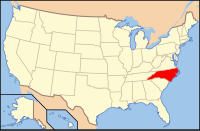Jackson County, North Carolina
| Jackson County, North Carolina | ||
|---|---|---|

Old Jackson County Courthouse in downtown Sylva
|
||
|
||
 Location in the U.S. state of North Carolina |
||
 North Carolina's location in the U.S. |
||
| Founded | 1851 | |
| Named for | Andrew Jackson | |
| Seat | Sylva | |
| Largest town | Sylva | |
| Area | ||
| • Total | 495 sq mi (1,282 km2) | |
| • Land | 491 sq mi (1,272 km2) | |
| • Water | 3.8 sq mi (10 km2), 0.8% | |
| Population | ||
| • (2010) | 40,271 | |
| • Density | 82/sq mi (32/km²) | |
| Congressional district | 11th | |
| Time zone | Eastern: UTC-5/-4 | |
| Website | www |
|
Jackson County is a county located in the southwest of the U.S. state of North Carolina. As of the 2010 census, the population was 40,271. Since 1913 its county seat has been Sylva, replacing Webster.
Jackson County comprises the Cullowhee, NC Micropolitan Statistical Area.
This area was part of Cherokee Nation territory at the time of European encounter. The trust land known as Qualla Boundary extends into part of Jackson County and is the base for the federally recognized tribe of the Eastern Band of Cherokee Indians. They contribute to the high proportion of Native Americans among the county population — more than ten percent.
The county was organized in 1851 from parts of Haywood and Macon counties. It was named for Andrew Jackson, President of the United States from 1829 to 1837. The original county courts were held at the Dan Bryson home in the community of Beta in Scott Creek township, and moved to Webster the following year.
In 1861 parts of Jackson and Henderson counties were combined to form Transylvania County. In 1871 parts of Jackson and Macon counties were combined to form Swain County. In 1913 Sylva became the county seat.
...
Wikipedia

